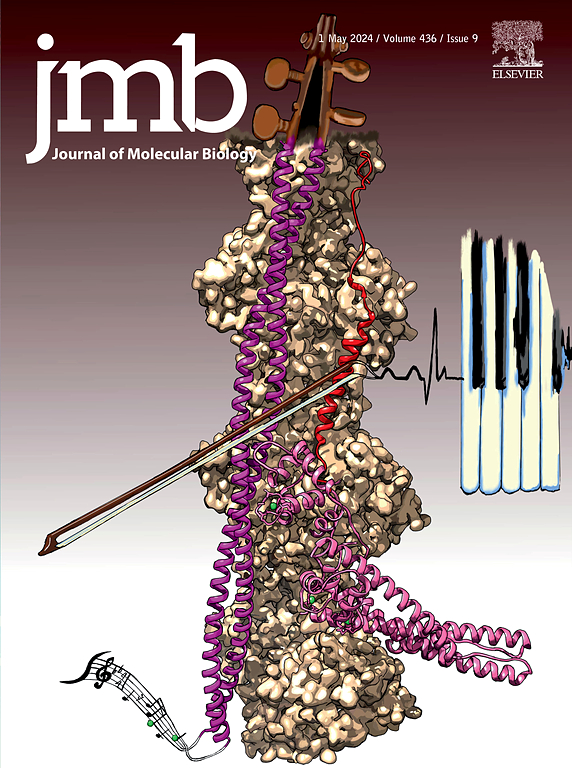分枝杆菌蛋氨酸氨基肽酶1c型作为30S核糖体亚基的抗关联因子。
IF 4.5
2区 生物学
Q1 BIOCHEMISTRY & MOLECULAR BIOLOGY
引用次数: 0
摘要
蛋氨酸氨基肽酶(Methionine aminopeptidase, MetAP)是一种重要的金属蛋白酶,通过在肽出口通道与70S核糖体结合,并从新生多肽链中去除n端蛋氨酸,在蛋白质合成中起着至关重要的作用。在大肠杆菌中,存在1型MetAP的单一亚类,而分枝杆菌具有两个亚类,MetAP1a和MetAP1c。两者之间的关键区别在于MetAP1c中存在一个额外的40个氨基酸长的n端延伸,这可能有助于不同的功能特性。在这项研究中,我们发现了分枝杆菌中MetAP1c的一种以前未被认识到的“兼职”功能。有趣的是,我们的研究结果表明,MetAP1c的表达在细菌生长的固定阶段特异性增强。此外,我们确定了MetAP1c与30S核糖体亚基之间的独特相互作用,揭示了其对小亚基的独特亲和力。耻垢分枝杆菌MetAP1c-30S亚基复合物的4.7 Å低温电镜图首次显示MetAP1c在30S亚基头部区域的亚基间表面结合。MetAP1c的结合诱导30S亚基的构象改变,削弱其与50S亚基结合的能力,从而赋予MetAP1c抗结合特性。为了进一步了解n端扩展的作用,我们构建了MetAP1c的两个突变变体,证实了它在这种兼职功能中的关键作用。MetAP1c的这种抗关联活性可能是分支杆菌中的能量守恒机制之一,其中MetAP1c参与固定期的翻译下调。本文章由计算机程序翻译,如有差异,请以英文原文为准。

Mycobacterial Methionine Aminopeptidase Type 1c Moonlights as an Anti-association Factor on the 30S Ribosomal Subunit
Methionine aminopeptidase (MetAP) is a vital metalloprotease that plays a crucial role in protein synthesis by binding to the 70S ribosome at the peptide exit tunnel and removing the N-terminal methionine from nascent polypeptide chains. In Escherichia coli, a single subclass of type 1 MetAP is present, whereas mycobacteria possess two subclasses, MetAP1a and MetAP1c. The key difference between these two is the presence of an additional 40 amino acid-long N-terminal extension in MetAP1c, which may contribute to distinct functional properties. In this study, we have uncovered a previously unrecognized “moonlighting” function of MetAP1c in mycobacteria. Interestingly, our results show that MetAP1c expression is specifically enhanced during the stationary phase of bacterial growth. Moreover, we identify a unique interaction between MetAP1c and the 30S ribosomal subunit, revealing its distinctive affinity for the small subunit. A 4.7 Å cryo-EM map of the Mycobacterium smegmatis MetAP1c-30S subunit complex demonstrates for the first time that MetAP1c binds at the inter-subunit face of the 30S subunit head region. The binding of MetAP1c induces conformational changes in the 30S subunit, impairing its ability to associate with the 50S subunit, thus imparting an anti-association property to MetAP1c. To further understand the role of the N-terminal extension, we constructed two mutant variants of MetAP1c, which confirmed its critical involvement in this moonlighting function. This anti-association activity of MetAP1c is likely one of the energy conservation mechanisms in mycobacteria where MetAP1c is involved in translation down regulation during stationary phase.
求助全文
通过发布文献求助,成功后即可免费获取论文全文。
去求助
来源期刊

Journal of Molecular Biology
生物-生化与分子生物学
CiteScore
11.30
自引率
1.80%
发文量
412
审稿时长
28 days
期刊介绍:
Journal of Molecular Biology (JMB) provides high quality, comprehensive and broad coverage in all areas of molecular biology. The journal publishes original scientific research papers that provide mechanistic and functional insights and report a significant advance to the field. The journal encourages the submission of multidisciplinary studies that use complementary experimental and computational approaches to address challenging biological questions.
Research areas include but are not limited to: Biomolecular interactions, signaling networks, systems biology; Cell cycle, cell growth, cell differentiation; Cell death, autophagy; Cell signaling and regulation; Chemical biology; Computational biology, in combination with experimental studies; DNA replication, repair, and recombination; Development, regenerative biology, mechanistic and functional studies of stem cells; Epigenetics, chromatin structure and function; Gene expression; Membrane processes, cell surface proteins and cell-cell interactions; Methodological advances, both experimental and theoretical, including databases; Microbiology, virology, and interactions with the host or environment; Microbiota mechanistic and functional studies; Nuclear organization; Post-translational modifications, proteomics; Processing and function of biologically important macromolecules and complexes; Molecular basis of disease; RNA processing, structure and functions of non-coding RNAs, transcription; Sorting, spatiotemporal organization, trafficking; Structural biology; Synthetic biology; Translation, protein folding, chaperones, protein degradation and quality control.
 求助内容:
求助内容: 应助结果提醒方式:
应助结果提醒方式:


